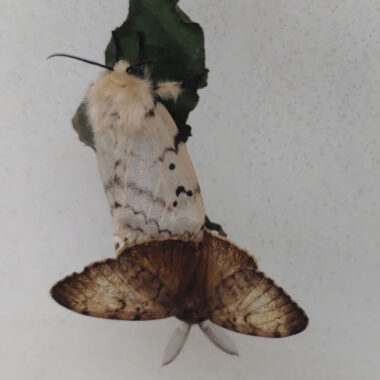LDD/Spongy Moth prevention tips
The Lymantria dispar dispar (LDD) moth also known as the “Spongy” and “Gypsy” moth is an invasive species that you may have noticed mostly during its caterpillar phase as it eats all the leaves on trees! Unfortunately, this insect has arrived in Ottawa, including Blackburn Hamlet. Homeowners are encouraged to monitor their hardwood trees like oaks, maples, birch, beech, blue spruce and walnut for the presence of LDD moth caterpillars and egg masses.
Why should we care?
- Loss of tree canopy weakens trees, and can contribute to tree mortality if it happens year over year.
- The caterpillar feces droppings (known as frass) cover the ground and objects near trees (cars, patio furniture, walk ways) causing slippery surfaces, and staining that makes your outdoor areas unenjoyable!
- The caterpillar hairs can cause a poison ivy-like reaction for some if touched.
- During an infestation the caterpillars do not just remain on trees but will cover vehicles, sides of houses, roofs, outdoor furniture, windows – everywhere!
What can you do to stop or reduce the impact?
We’ve compiled some control measures and timelines to assist residents in managing this pest.
| Moth Stage | Control Measure | Do This In | |
|---|---|---|---|
| Egg | Removal of egg masses | August – May | 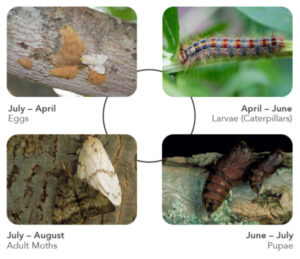 |
| Caterpillars | Tree wrapping | Mid-April – July | |
| Pupae | Removal of pupae | June – August | |
| Moth | Install and monitor moth traps | June – August |
LDD Moth
-
1. Eggs
-
2. Caterpillars
-
3. Pupae
-
4. Moths
-
Additional Resources
Remove and Destroy Egg Masses (July to April)
This is one of the best ways to reduce the infestation – every egg mass removed will reduce the population by several thousand! LDD egg masses are orangey yellow in colour and have a fuzzy/spongy or moss-like appearance. These relatively small masses (the size of a loonie) can carry hundreds and even thousands of eggs.
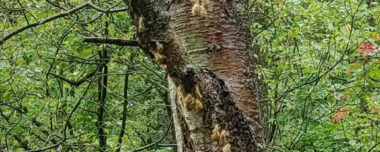
Where to look
- Tree trunks and branches
- Walls of your house
- Wheel well of your vehicle
- Patio furniture
- Rocks
- Shed
 How to remove and destroy egg masses
How to remove and destroy egg masses
- Important – be careful at all times, especially if on a ladder and when holding a knife or any sharp object!
- Using a hard flat surface such as a knife, paint scraper or putty knife, scrape off egg masses into a container. Use care to avoid damaging the tree bark.
- Add dish detergent and water to the container and let sit for two days
- Discard solution and egg mixture.
NOTE: Don’t just scrape egg masses onto the ground or try to crush them with your shoe as they will survive to hatch next spring. Any parts of the egg mass you are unable to scrape off can also hold surviving eggs.
Caterpillars – Barrier Bands & Tree Wrapping (April – June)
 Barrier Bands Just after the caterpillars have hatched, when they are small and young, barrier bands will prevent them from climbing back into trees after ballooning or when they have fallen. Barrier bands can be purchased or made using duct tape or other nonporous material that can be wrapped around a tree trunk and coated with a commercially available sticky material such as TangleFoot® or Vaseline®. NEVER put sticky material directly on the tree trunk.
Barrier Bands Just after the caterpillars have hatched, when they are small and young, barrier bands will prevent them from climbing back into trees after ballooning or when they have fallen. Barrier bands can be purchased or made using duct tape or other nonporous material that can be wrapped around a tree trunk and coated with a commercially available sticky material such as TangleFoot® or Vaseline®. NEVER put sticky material directly on the tree trunk.
Tree wrapping is most effective when the caterpillars are larger in size. It consists of wrapping burlap around the trunk of trees to catch caterpillars that come down from tree branches during the heat of the day or those trying to make their way up from the ground.
- Wrap burlap around the trunk of a tree to create a barrier and shady hiding place for the caterpillars.
- Here are some instructions on how to wrap the burlap: https://www.toronto.ca/wp-content/uploads/2020/02/8b53-european-gypsy-moth-resident-make-burlap-caterpillar-trap.pdf
- Check the burlap daily to remove and destroy any caterpillars. Remove and place caterpillars in a dish detergent and water solution for 48 hours.
- When caterpillars have pupated (transformed into cocoons), remove burlap (around mid to late June)
- If pupae are attached to burlap, either remove and destroy manually or submerse the burlap in a dish detergent and water solution for two days.
Spraying of Trees If you are interested in spraying your trees with a product to control the caterpillars, they must be applied in the spring. There are two options: biological and chemical pesticides. For assistance in applying insecticides, we recommend contacting a certified arborist.
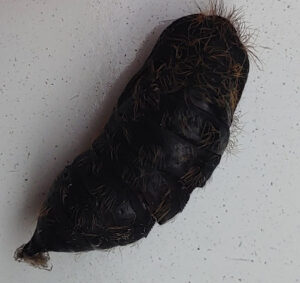 Removal of pupae in June to August
Removal of pupae in June to August
- Squish by hand against the tree or using a hard flat surface such as a knife, paint scraper or putty knife, scrape off pupae into a container. Take care to not damage the bark.
- Add dish detergent and water to the container and let sit for two days
- Discard solution with pupae after 48 hours.
NOTE: do not just scrape and leave on the ground as they will hatch anywhere!
Install and monitor moth traps from June to August
While female LDD moths (white moth in the photo) have wings, they do not fly. The female moth emanates pheromones to attract male moths (brown moth in the photo). Moth traps are made using a female pheromone lure to attract the male moths in order to destroy them.
To acquire a LDD moth trap, please check your local hardware store or with an arborist and our tree team may also have some lures/traps available.
If you have any questions, would like to help deal with an infested tree or would like to find out more, please contact the Tree Team at treeteam@blackburnhamlet.ca.
City of Ottawa
https://ottawa.ca/en/living-ottawa/environment-conservation-and-climate/trees-and-urban-forests/tree-and-forest-health/gypsy-moths
Government of Ontario
https://www.ontario.ca/page/lymantria-dispar-dispar-ldd-moth
Lanark County LDD moth Fact Sheet
https://www.lanarkcounty.ca/en/roads-trails-and-transit/resources/Documents/Gypsy-Moth-Fact-Sheet.pdf
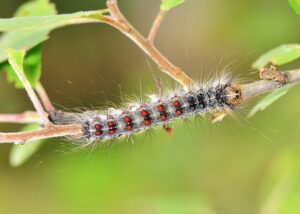 |
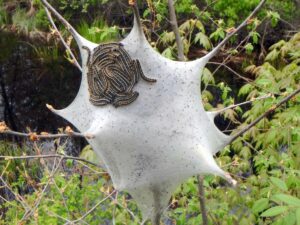 |
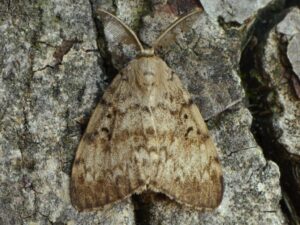 |


